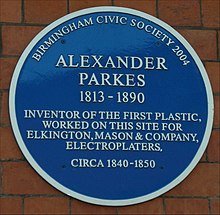Alexander Parkes
Alexander Parkes | |
|---|---|
| Born | 29 December 1813 Suffolk Street,Birmingham,England |
| Died | 29 June 1890(aged 76) |
| Nationality | English |
| Occupation | Engineer |
| Engineering career | |
| Projects | Parkesine |
Alexander Parkes(29 December 1813 – 29 June 1890) was ametallurgistand inventor fromBirmingham,England. He createdParkesine,the first man-madeplastic.
Biography
[edit]The son of a manufacturer ofbrasslocks,Parkes was apprenticed to Messenger and Sons, brassfoundersof Birmingham, before going to work forGeorge and Henry Elkington,who patented theelectroplatingprocess.[1]Parkes was put in charge of the casting department, and his attention soon began to focus on electroplating. Parkes took out his first patent (No. 8905) in 1841 on a process for electroplating delicate works of art. His improved method for electroplating fine and fragile objects, such as flowers, was granted a patent in 1843. The process involved electroplating an object previously dipped in a solution ofphosphoruscontained inbisulphide of carbon,and then innitrate of silver.A spider's web, silver-plated according to this method, was presented toPrince Albertwhen he visited the Elkington works in 1844.
In total Parkes held at least 66 patents on processes and products, mostly related to electroplating and to development of plastics.
- In 1846, he patented the cold cure process for vulcanizing rubber, called byThomas Hancock"one of the most valuable and extraordinary discoveries of the age".[2]
- He pioneered the addition of small quantities of phosphorus to metals and alloys, and developed phosphor-bronze (patent 12325 of 1848, taken out jointly with his brotherHenry Parkes).[3]
- In 1850, he developed and patented theParkes processfor economically desilveringlead,also patenting refinements to the process in 1851 and 1852.[4]
- In 1856, he patentedParkesine– the firstthermoplastic– acelluloidbased onnitrocellulosetreated with a variety of solvents.[5]This material, exhibited at the 1862 London International Exhibition, anticipated many of the modern aesthetic and utility uses of plastics.
- In 1866, he set up The Parkesine Company atHackney Wick,London, for bulk low-cost production. It was not commercially successful, however, for Parkesine was expensive to produce, prone to cracking and highly flammable. The business closed in 1868.
- Parkes' material was developed later in improved form asXyloniteby his associateDaniel Spill,who brought a patent infringement lawsuit – ultimately unsuccessful – againstJohn Wesley Hyatt,developer ofcelluloidin the US. In 1870, however, the judge ruled that Parkes was the true inventor, owing to his original experiments.
Personal and family details
[edit]Alexander Parkes was born at Suffolk Street, Birmingham, the fourth son of James Mears Parkes and his wife Kerenhappuch Childs.Samuel Harrison,described by SirJosiah Masonas the inventor of the split-ring (or key-ring) and widely credited with the invention of the steel pen, was his great-uncle.[6]Parkes was twice married. By his first marriage, to Jane Henshall Moore (1817–50), he had four sons and two daughters (the cricketerHoward Parkeswas a grandson), and by his second marriage, to Mary Ann Roderick (1835–1919), four sons and seven daughters. The elder surviving son of his second marriage, Alexander Parkes junior, sometime President of theAssociation of Certified and Corporate Accountants,presented many original specimens of Parkesine to theScience Museumin 1937, the core of the museum's Parkesine collection.[7]
Parkes' younger brother Henry (1824–1909), a trained chemist, who was married to Fanny Roderick (1837–97), a sister of Alexander's second wife, assisted him in many of his experiments during a collaboration lasting more than fifty years.[8]
It is believed that the Parkes family descends from the Rev. Michael Parkes, Vicar ofPenkridge,Staffordshire (died 1617), and had close connections with the metal-working towns ofWednesburyandWolverhamptonin the 16th, 17th and 18th centuries.[9]
Legacy
[edit]
Parkes is remembered in several locations:
- ThePlastics Historical Societyplaced ablue plaqueon his home inDulwich,London, in 2002;
- The Birmingham Civic Societyerected a blue plaque commemorating him in 2004 on the original Elkington Silver Electroplating Works (the oldScience Museum),Newhall Street,Birmingham;[10]
- There is also a plaque on the wall of the site of the Parkesine Works.[11]
In September 2005, Parkes was posthumously inducted into the AmericanPlastics Academy's Hall of Fame.[12]He is buried inWest Norwood Cemetery,London, although his memorial was removed in the 1970s.
References
[edit]- ^Anon, A Short Memoir of Alexander Parkes (1813–1890), Chemist and Inventor, Printed for Private Circulation, n.d.,c.1890; John Naish Goldsmith, Alexander Parkes, Xylonite and Celluloid, 1934; M. Kaufman, The First Century of Plastics, 1963.
- ^M. Kaufman, op. cit., p. 17
- ^Obituary in Iron, pp. 73–4, 25 July 1890.
- ^"Parkes process (chemistry)".Britannica Online Encyclopedia.Britannica Online Encyclopedia.Retrieved20 August2009.
- ^UK Patent Office (1857).Patents for inventions.UK Patent Office. p. 255.
- ^J.T.Bunce, Memoir of Sir Josiah Mason, p. 208; Simon Parkes, A Tale of Two Knives, Midland Ancestor, vol. 8, no. 4, June 1987. Henry Bore, The Story of the Invention of Steel Pens, 1890, at p. 20 says that Harrison made a steel pen forJoseph Priestleyin about 1780, "probably the first steel pen ever produced."
- ^The Times,8 March 1937.
- ^Anon, Op. Cit., p.14.
- ^William Percy Webb, Notes on the Parkes Family, typescript c. 1930, in Society of Genealogists Library, London.
- ^"Blue Plaques".UK:The Birmingham Civic Society.Archived fromthe originalon 29 September 2011.Retrieved28 April2014.
- ^"First plastic in the world".UK:London Borough of Hackney.Archived fromthe originalon 4 March 2016.Retrieved28 April2014.
- ^"Alexander Parkes".US:Plastics Hall of Fame. Archived fromthe originalon 29 April 2014.Retrieved28 April2014.
External links
[edit]- Plastics Historical Society
- New materials: Plastics–Making the Modern Worldonline exhibit,Science Museum, London.
- Friends of West Norwood Cemetery– Newsletter, May 2002,A Plastic Plaque for Parkes.
